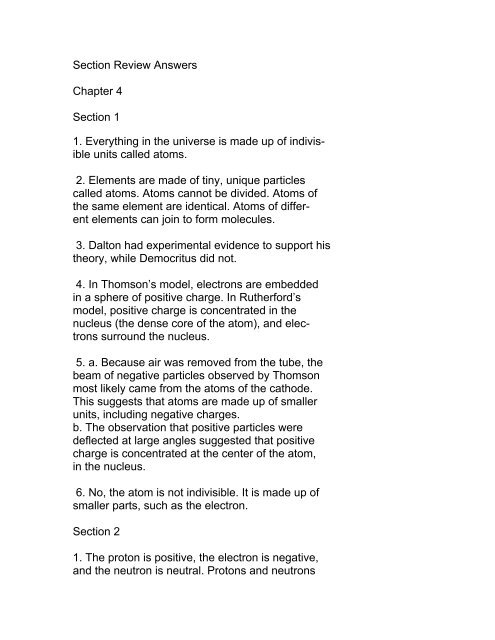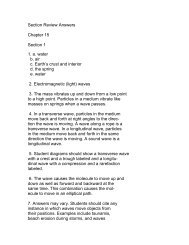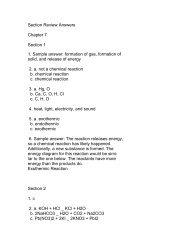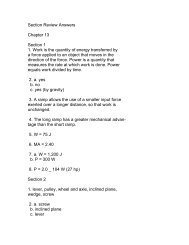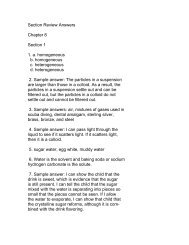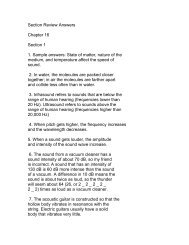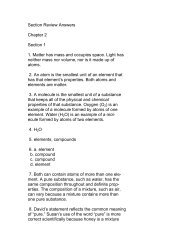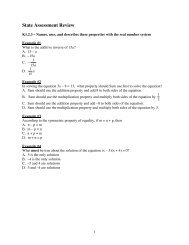Section Review Answers Chapter 4 Section 1 1. Everything in the ...
Section Review Answers Chapter 4 Section 1 1. Everything in the ...
Section Review Answers Chapter 4 Section 1 1. Everything in the ...
You also want an ePaper? Increase the reach of your titles
YUMPU automatically turns print PDFs into web optimized ePapers that Google loves.
<strong>Section</strong> <strong>Review</strong> <strong>Answers</strong><strong>Chapter</strong> 4<strong>Section</strong> 1<strong>1.</strong> <strong>Everyth<strong>in</strong>g</strong> <strong>in</strong> <strong>the</strong> universe is made up of <strong>in</strong>divisibleunits called atoms.2. Elements are made of t<strong>in</strong>y, unique particlescalled atoms. Atoms cannot be divided. Atoms of<strong>the</strong> same element are identical. Atoms of differentelements can jo<strong>in</strong> to form molecules.3. Dalton had experimental evidence to support his<strong>the</strong>ory, while Democritus did not.4. In Thomson’s model, electrons are embedded<strong>in</strong> a sphere of positive charge. In Ru<strong>the</strong>rford’smodel, positive charge is concentrated <strong>in</strong> <strong>the</strong>nucleus (<strong>the</strong> dense core of <strong>the</strong> atom), and electronssurround <strong>the</strong> nucleus.5. a. Because air was removed from <strong>the</strong> tube, <strong>the</strong>beam of negative particles observed by Thomsonmost likely came from <strong>the</strong> atoms of <strong>the</strong> cathode.This suggests that atoms are made up of smallerunits, <strong>in</strong>clud<strong>in</strong>g negative charges.b. The observation that positive particles weredeflected at large angles suggested that positivecharge is concentrated at <strong>the</strong> center of <strong>the</strong> atom,<strong>in</strong> <strong>the</strong> nucleus.6. No, <strong>the</strong> atom is not <strong>in</strong>divisible. It is made up ofsmaller parts, such as <strong>the</strong> electron.<strong>Section</strong> 2<strong>1.</strong> The proton is positive, <strong>the</strong> electron is negative,and <strong>the</strong> neutron is neutral. Protons and neutrons
are found <strong>in</strong> <strong>the</strong> nucleus and are massive(m = <strong>1.</strong>67 _ 10–27 kg) compared to <strong>the</strong> electrons(m = 9.11 _ 10–31 kg), which are found outside<strong>the</strong> nucleus.2. Atomic number is <strong>the</strong> number of protons only.The number of electrons equals <strong>the</strong> numberof protons <strong>in</strong> a neutral atom. Mass number is<strong>the</strong> total number of protons and neutrons. Thenumber of neutrons is found by subtract<strong>in</strong>g <strong>the</strong>atomic number from <strong>the</strong> mass number.3. The proton def<strong>in</strong>es <strong>the</strong> element because eachelement always has <strong>the</strong> same number of protons,while <strong>the</strong> number of neutrons and electrons canvary.4. Atoms of <strong>the</strong> same element can have differentmasses because <strong>the</strong>y can have different numbersof neutrons. These “versions” of each element arecalled isotopes.5. a. 14 – 6 = 8b. 15 – 7 = 8c. 35 – 16 = 19d. 45 – 20 = 256. The unified atomic mass unit (u)7. Avogadro’s constant is 6.022 _ 1023/mol. Itis <strong>the</strong> number of particles <strong>in</strong> one mole of asubstance.8. a. 54.94 g/mol Mnb. 112.41 g/mol Cdc. 74.92 g/mol Asd. 87.62 g/mol Sr9. Yes. The atom is normally neutral because<strong>the</strong> protons and electrons are balanced. If an
3. When an electron jumps between levels, <strong>the</strong>atom ei<strong>the</strong>r ga<strong>in</strong>s or loses energy <strong>in</strong> <strong>the</strong> formof photons.4. The third energy level can hold 18 electrons:2 <strong>in</strong> <strong>the</strong> s orbital, 2 <strong>in</strong> each of 3 p orbitals (for6 total), and 2 <strong>in</strong> each of 5 d orbitals (for 10total).5. Each rung of <strong>the</strong> ladder represents an energylevel. Electrons can be only on <strong>the</strong> rungs, notbetween rungs. A ladder is not a good modelfor an atom because electrons exist <strong>in</strong> threedimensionalorbitals.6. In Bohr’s model, <strong>the</strong> electrons travel alongfixed paths. In <strong>the</strong> modern model, electronsbehave more like waves on a str<strong>in</strong>g than likeparticles.7. Nitrogen has 7 electrons, so <strong>the</strong>re are 2 <strong>in</strong><strong>the</strong> first level and 5 <strong>in</strong> <strong>the</strong> second level. Thus,nitrogen has 5 valence electrons.End of chapter <strong>Review</strong> <strong>Answers</strong>Us<strong>in</strong>g Key Terms2. In <strong>the</strong> nucleus, a silicon atomhas 14 protons, and it usually has14 neutrons. A silicon atom has14 electrons, four of which arevalence electrons.3. Atomic number tells <strong>the</strong> numberof protons <strong>in</strong> <strong>the</strong> atom. All atomsof <strong>the</strong> same element have <strong>the</strong>same number of protons, so <strong>the</strong>yhave <strong>the</strong> same atomic number.The mass number is <strong>the</strong> totalnumber of protons and neutrons
<strong>in</strong> an atom. The number of neutronscan vary, so <strong>the</strong> mass numbercan vary among atoms of <strong>the</strong>same element. These differentatoms are called isotopes.4. The molar mass is <strong>the</strong> mass ofone mole, or 6.022 _ 1023 particles,of <strong>the</strong> element.5. An orbital is a region <strong>in</strong> <strong>the</strong> atomwhere <strong>the</strong>re is a high probabilityof f<strong>in</strong>d<strong>in</strong>g electrons.Understand<strong>in</strong>g Key Ideas6. a7. b8. d9. c10. a1<strong>1.</strong> b12. b13. cMath Skills27. <strong>1.</strong>5 g Fe _ 1 mol Fe/55.85 g Fe = 0.027 mol Fe28. 15.1 mol Al _ 26.98 g Al/1 mol Al = 407 g Al


